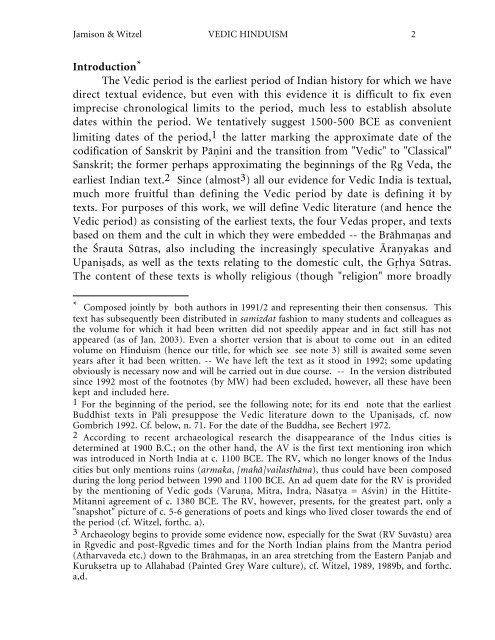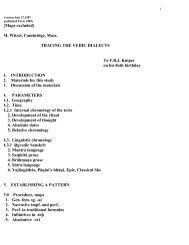VEDIC HINDUISM by S. W. Jamison and M. Witzel - people.fas ...
VEDIC HINDUISM by S. W. Jamison and M. Witzel - people.fas ...
VEDIC HINDUISM by S. W. Jamison and M. Witzel - people.fas ...
Create successful ePaper yourself
Turn your PDF publications into a flip-book with our unique Google optimized e-Paper software.
<strong>Jamison</strong> & <strong>Witzel</strong> <strong>VEDIC</strong> <strong>HINDUISM</strong> 2<br />
Introduction*<br />
The Vedic period is the earliest period of Indian history for which we have<br />
direct textual evidence, but even with this evidence it is difficult to fix even<br />
imprecise chronological limits to the period, much less to establish absolute<br />
dates within the period. We tentatively suggest 1500-500 BCE as convenient<br />
limiting dates of the period,1 the latter marking the approximate date of the<br />
codification of Sanskrit <strong>by</strong> På�ini <strong>and</strong> the transition from "Vedic" to "Classical"<br />
Sanskrit; the former perhaps approximating the beginnings of the �g Veda, the<br />
earliest Indian text.2 Since (almost3) all our evidence for Vedic India is textual,<br />
much more fruitful than defining the Vedic period <strong>by</strong> date is defining it <strong>by</strong><br />
texts. For purposes of this work, we will define Vedic literature (<strong>and</strong> hence the<br />
Vedic period) as consisting of the earliest texts, the four Vedas proper, <strong>and</strong> texts<br />
based on them <strong>and</strong> the cult in which they were embedded -- the Bråhma�as <strong>and</strong><br />
the Śrauta Sūtras, also including the increasingly speculative Āra�yakas <strong>and</strong><br />
Upani�ads, as well as the texts relating to the domestic cult, the G�hya Sūtras.<br />
The content of these texts is wholly religious (though "religion" more broadly<br />
* Composed jointly <strong>by</strong> both authors in 1991/2 <strong>and</strong> representing their then consensus. This<br />
text has subsequently been distributed in samizdat <strong>fas</strong>hion to many students <strong>and</strong> colleagues as<br />
the volume for which it had been written did not speedily appear <strong>and</strong> in fact still has not<br />
appeared (as of Jan. 2003). Even a shorter version that is about to come out in an edited<br />
volume on Hinduism (hence our title, for which see see note 3) still is awaited some seven<br />
years after it had been written. -- We have left the text as it stood in 1992; some updating<br />
obviously is necessary now <strong>and</strong> will be carried out in due course. -- In the version distributed<br />
since 1992 most of the footnotes (<strong>by</strong> MW) had been excluded, however, all these have been<br />
kept <strong>and</strong> included here.<br />
1 For the beginning of the period, see the following note; for its end note that the earliest<br />
Buddhist texts in Påli presuppose the Vedic literature down to the Upani�ads, cf. now<br />
Gombrich 1992. Cf. below, n. 71. For the date of the Buddha, see Bechert 1972.<br />
2 According to recent archaeological research the disappearance of the Indus cities is<br />
determined at 1900 B.C.; on the other h<strong>and</strong>, the AV is the first text mentioning iron which<br />
was introduced in North India at c. 1100 BCE. The RV, which no longer knows of the Indus<br />
cities but only mentions ruins (armaka, [mahå]vailasthåna), thus could have been composed<br />
during the long period between 1990 <strong>and</strong> 1100 BCE. An ad quem date for the RV is provided<br />
<strong>by</strong> the mentioning of Vedic gods (Varu�a, Mitra, Indra, Nåsatya = Aśvin) in the Hittite-<br />
Mitanni agreement of c. 1380 BCE. The RV, however, presents, for the greatest part, only a<br />
"snapshot" picture of c. 5-6 generations of poets <strong>and</strong> kings who lived closer towards the end of<br />
the period (cf. <strong>Witzel</strong>, forthc. a).<br />
3 Archaeology begins to provide some evidence now, especially for the Swat (RV Suvåstu) area<br />
in �gvedic <strong>and</strong> post-�gvedic times <strong>and</strong> for the North Indian plains from the Mantra period<br />
(Atharvaveda etc.) down to the Bråhma�as, in an area stretching from the Eastern Panjab <strong>and</strong><br />
Kuruk�etra up to Allahabad (Painted Grey Ware culture), cf. <strong>Witzel</strong>, 1989, 1989b, <strong>and</strong> forthc.<br />
a,d.

















